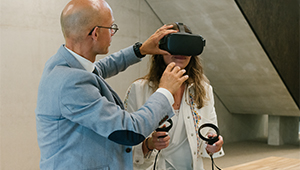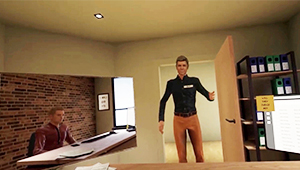1 Using virtual
reality to fight burnout... how did you come up with that idea?
"The idea crept up on me slowly. As an anaesthesiologist, I use virtual reality in my practice to help people relax, to relieve pain. While reading up on VR, I discovered out that virtual reality can make a difference, especially in the area of mental health.
When I took over as the department head, I also became interested in methods to prevent professional burnout. And so I was pleasantly surprised when a speaker at a conference told us that VR can be used as a behaviour modification technique. In a virtual reality environment, we can get people to analyse their problems from the perspective of a third person. This is a very interesting angle to explore in the treatment of burnout. After talking with both VR and burnout experts like Professor Lode Godderis, I was quickly convinced of the upside potential."
2 And how does AG fit in with this development?
"At the hospital where I work, I had already been in contact with AG regarding the reorganisation of our services as well as patient access to VR and how to claim back the costs. When I mentioned that I specifically wanted to work on solutions for burnout syndrome, AG was very interested.
Burnout is a major issue for them. They offered to provide financial support for my project and get their partners involved in the process, as this would give me easy access to therapists and experts in the field of burnout. For example, Ternat Medical Centre, where Professor Sara De Gieter carries out scientific research with her team from the Department of Psychology (VUB). Together we’re developing the research protocols."
"If you can prepare people for a difficult event - going back to work after long-term sick leave - you get a better outcome."
3
How exactly does VR therapy work? And where is it being used?
"Our research is focused on two areas: returning to work after burnout and preventing burnout.
To address the first area, I started developing a VR return-to-work module in consultation with Professor Godderis. It's an experience that sends people back to work virtually, so they’re better prepared for the real challenges of returning to work.
Via the VR headset, the patient experiences different stressors: colleagues dropping by for a chat, the boss asking them to give a presentation, etc. This VR experience happens under the supervision of their therapist and afterwards they talk about it together. As a second step, the patient can take the VR headset home to practice. So we’re turning the experience into a medical treatment, which is why VR therapy needs to be scientifically proven.
The second area, prevention, is just as important because knowledge in the workplace about burnout is often still lacking. The signs go undetected, managers don't realise they're creating a culture that's not ideal, etc. Developing an experience that raises
awareness of burnout is a completely different branch of VR technology. Research shows that we retain better what we learn in virtual reality than what we read in books. Prevention consultants can use this VR experience when companies want to train their managers on how to prevent burnout."

|
|

| 
|
4 Imagine that there are no limits... what's your ultimate goal with this project?
"The advantage of VR is that it's very easy for anyone to use. The equipment is small, and it has become increasingly affordable. You can now buy a very decent VR headset for as little as 250 euros. So VR is now quite readily
available to anyone who needs it, anywhere in the world, to prevent burnout or help ease people back into the workplace.
In the future, I hope we'll be able to offer
the most individually tailored VR experience. To make this happen, we're working with One Bonsai, the market leader in Flanders in the field of VR for medical applications."
5 Are there risks or pitfalls we should keep in mind?
"The first pitfall is
wanting to go too fast and believing too much in your own product. You have to believe in your product, of course, but until it's thoroughly tested, it's hard to say that it really works. It needs to be scientifically proven. That takes a lot of time, plus it's expensive and often quite complicated. But if you want to put something out on the market and claim that it makes people feel better, you have to be able to prove it.
A second pitfall is
wanting to go too far with the VR experience. If patients are exposed to too many stressors, to what extent will it be a step backwards in their recovery process? On the other hand, maybe that should be the point: when figuring out how ready patients are to return to work, it's better for them to have a setback in a virtual work environment instead of a real one.
In short, we shouldn't lose sight of our objective, which is to help people recover from burnout. So technology shouldn't be used as a starting point, but as a tool to determine whether the next step is still the right solution. And that requires constant mental gymnastics."
6 Can VR therapy accelerate the return-to-work process?
"I can't say for sure right now, but the dozens of therapists I've talked to really see value in it. If you can
prepare people for a difficult event - going back to work after long-term sick leave - you get a better outcome. The same holds true for prevention: VR can be used to teach people things. We can bring emotions into the learning process. It's learning by experience, and that makes you remember everything better.
As for whether it helps get people back to work after burnout, that still needs to be tested, so I can't say yet either way. Otherwise, I'd already be a few steps ahead. Being able to objectively prove that it works, that we can get people back in the workplace and cut down on the time they spend on sick leave, that's the
Holy Grail for me. And if it doesn't work, we need proof of that too."
7 How far along are you, and what are the next steps?
"The first step in the clinical validation of the VR return-to-work module was
to test it with 20 volunteers. We asked them if the VR experience was realistic, if it gave them the feeling of being in the workplace and if they also experienced stress in this virtual world. For this, the virtual environment doesn't need to be an exact copy of the workplace, as the brain can easily make the link. And the results were positive: on the one hand, it was found that the VR experience causes an increase in stress and, on the other hand, people really do have the impression that they're at work and that the virtual situation feels like reality. These are certainly encouraging results, although we must remember that we tested on a small group.
The second step, which will start soon, is
a feasibility study with a dozen or so patients at Ternat Medical Centre, one of AG's partners in its Return To Work programme. The objective is to work closely with therapists and their clients to get a good idea about the user-friendliness and clinical effect of the VR solution. This is an important step because it allows us to detect and resolve any major issues before moving on to larger-scale testing.
The third step, which will begin in 2023, is
a major clinical validation. We will compare a group of burnout patients using VR to a group without VR. This clinical data is obviously essential to demonstrate the value of the VR solution. At the same time, it's also a first step in getting CE marking, a process that can take up to two years.
For the time being, the focus is wholly on return-to-work. But as there's also a clear demand for the prevention capabilities of VR, this next step is certainly not far off. To be able to offer VR to all possible users, I need to set up an appropriate structure and get the necessary funding. I'm currently working on the business model and putting together a team that will take on this challenge. It's an intensive process, but
the prospect of using innovative technology to help a large group of people is an amazing opportunity."
Thank you for this open conversation. We wish you all the best and look forward to finding out what happens next!
Who is Arnaud Bosteels?
- Belgian anaesthesiologist and founder of the Virtual Reality Unit at Clinique St-Jean in Brussels
- Researcher and Director of Melimpus
-
Linkedin
|
|
|---|
Long-term sick leave and getting people back to work safely and successfully is a topic that AG Employee Benefits takes to heart. That's why we launched the successful
Return To Work assistance programmes as an integral part of our income protection insurance
Income Care.
Want to learn more?
Just make an appointment with your trusted contact person or one of our sales managers.





